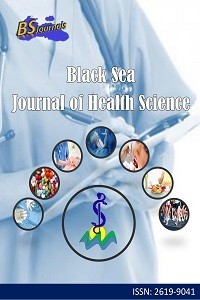Yanık Merkezindeki Hastaların Yara Kültürlerinden İzole Edilen Mikroorganizmalar ve Antibiyotik Duyarlılıkları
Pseudomonas aeruginosa, Acinetobacter spp, Yanık, Yara sürüntü kültürü
Microorganisms and Their Antibiotic Susceptibilities Isolated from Wound Cultures of Patıents in a Burns Center
Pseudomonas aeruginosa, Acinetobacter spp, Burn, Wound swab culture,
___
- Abesamis GMM, Cruz JJV. 2019. bacteriologic profile of burn wounds at a tertiary government hospital in the Philippines-UP-PGH ATR burn center. J Burn Care Res, 40(5): 658-668. DOI: 10.1093/jbcr/irz06.
- Al B, Yildirim C, Coban S, Aldemir M, Güloğlu C. 2009. Mortality factors in flame and scalds burns: our experience in 816 patients. Turkish J Trauma Emerg Surg, 15(6): 599-606.
- Altoparlak U, Erol S, Akcay MN, Celebi F, Kadanali A. 2004. The time-related changes of antimicrobial resistance patterns and predominant bacterial profiles of burn wounds and body flora of burned patients. Burns, 30(7): 660664. DOI: 10.1016/j.burns.2004.03.005.
- Avni T, Levcovich A, Ad-El DD, Leibovici L, Paul M. 2010. Prophylactic antibiotics for burns patients: systematic review and meta-analysis. BMJ Clin Res, 340: c241. DOI: 10.1136/bmj.c241.
- Aygıt AC, Pilanci Ö, Mercan EŞ. 2012. Evaluation of burn wound ınfection among pediatric patients in the age range of 0-12 years in a burn unit. JAREM, 2: 55-58.
- Bayram Y, Parlak M, Aypak C, Bayram I. 2013. Three-year review of bacteriological profile and antibiogram of burn wound isolates in Van, Turkey. Int J Medic Sci, 10(1): 19-23. DOI: 10.7150/ijms.4723.
- Bourgi J, Said JM, Yaakoub C, Atallah B, Al Akkary N, Sleiman Z, Ghanimé G. 2020. Bacterial infection profile and predictors among patients admitted to a burn care center: A retrospective study. Burns, 46(8): 1968-1976. DOI: 10.1016/j.burns.2020.05.004.
- Chim H, Tan BH, Song C. 2007. Five-year review of infections in a burn intensive care unit: High incidence of Acinetobacter baumannii in a tropical climate. Burns, 33(8): 1008-1014. DOI: 10.1016/j.burns.2007.03.003.
- Çınal H, Barın EZ. 2020. Five years of experience in a burn care unit: Analysis of burn injuries in 667 patients. Van Med J, 27(1): 56-62.
- Diler B, Dalgıç N, Karadağ ÇA, Dokucu Aİ. 2012. Epidemiology and ınfections in a pediatric burn unit: experience of three years. J Pediatr Inf; 6: 40-45.
- Greenhalgh DG. 2010. Burn resuscitation: the results of the ISBI/ABA survey. Burns, 36(2): 176-182. DOI: 10.1016/j.burns.2009.09.004.
- Güldoğan CE, Kendirci M, Tikici D, Gündoğdu E, Yastı AÇ. 2017. Clinical infection in burn patients and its consequences. Turkish J Trauma Emerg Surg, 23(6): 466-471. DOI: 10.5505/tjtes.2017.16064.
- Koneman EW, Allen SD, Janda JM, Schreckenberger PC, Winn WC. 1997. Color atlas and textbook of diagnostic microbiology. 5th ed, Lippincott, Philadelphia, US.
- Kumar S, Ali W, Verma AK, Pandey A, Rathore S. 2013. Epidemiology and mortality of burns in the Lucknow Region, India--a 5 year study. Burns, 39(8): 1599-1605. DOI: 10.1016/j.burns.2013.04.008.
- Luo G, Peng Y, Yuan Z, Cheng W, Wu J, Fitzgerald M. 2011. Yeast from burn patients at a major burn centre of China. Burns, 37(2): 299-303. DOI: 10.1016/j.burns.2010.03.004.
- Mayhall CG. 1999. Nosocomial burn wounds. Mayhall CG (ed). Hospital Epidemiology and Infection Control. 2nd Ed,: Lippincot Williams Wilkins, Philadelphia , US, pp: 275-286.
- Polat Y, Karabulut A, Balcı Yİ, Çilengir M, Övet G, Cebelli S. 2010. Evaluation of culture and antibiogram results in burned patients. Pamukkale Medic J, 3: 131-135.
- Qader AR, Muhamad JA. 2010. Nosocomial infection in sulaimani burn hospital, Iraq. Annals Burns Fire Disast, 23(4): 177-181.
- Yıldırım AM, Çarkçı HA, Yılmaz M, Toraman ZA. 2019. Determinatıon of species of microorganism insulated from burn and wound samples and investigation of antimicrobial sensitivity. Kocatepe Medic J, 20(1): 26-32.
- Yurtsever SG, Kurultay N, Çeken N, Yurtsever Ş, Afşar İ, Şener A, Yılmaz N. 2009. Yara yeri örneklerinden izole edilen mikroorganizmalar ve antibiyotik duyarlılıklarının değerlendirilmesi. ANKEM Derg, 23(1): 34-38.
- Zerbaliyev E. 2013. Kuruluşundan Bugüne Hacettepe Üniversitesi Tıp Fakültesi Genel Cerrahi Anabilim Dalı Yanık Ünitesi’nde Yatarak İzlenen Hastalarda Tedavi Etkinliğinin Retrospektif Değerlendirilmesi. Uzmanlık tezi, Hacettepe Üniversitesi Tıp Fakültesı Genel Cerrahi Anabilim Dalı, Ankara, Türkiye, pp: 114.
- Zheng Y, Lin G, Zhan R, Qian W, Yan T, Sun L, Luo G. 2019. Epidemiological analysis of 9,779 burn patients in China: An eight-year retrospective study at a major burn center in southwest China. Exp Therapeutic Medic, 17(4): 2847-2854. DOI: 10.3892/etm.2019.7240.
- Yayın Aralığı: Yılda 4 Sayı
- Başlangıç: 2018
- Yayıncı: Cem TIRINK
Cocaine-Filled Capsule Detected after Firearm Injury: A Case Report
Nafis VURAL, Murat DUYAN, Ali SARIDAŞ
Türk Pediatri Popülasyonunda Adenotonsiller Boyut Dağılımı ve Orta Kulak Üzerine Etkisi
Muhammed Gazi YILDIZ, İsrafil ORHAN, Dogan ÇAKAN, Mustafa PAKSOY, Adem DOĞANER
Mustafa Serhat ŞAHİNOĞLU, Sevil ALKAN
Mehmet YETİŞ, Mehmet CANLI, Ömer Alperen GÜRSES, Hikmet KOCAMAN, Ozkan GORGULU
Investigation of the Perceived Corporate Image and Organizational Commitment of Nurses and Midwives
Tuğba GÜNGÖR, Ayşegül OKSAY ŞAHİN
Protez Enfeksiyonları Konulu Bilimsel Çıktıların Analizi
Canan ERAYDIN, Berkay ÇORBACI, Üzeyir DİNİ, Hamza UYSAL, Esra YILDIRIM
The Impact of Temperature on the Synthesis of Silver Nanoparticles by Candida macedoniensis
Mirmusa JAFAROV, Khudaverdi GANBAROV, Ergin KARİPTAŞ, Sanam HUSEYNOVA, Sevinj GULIYEVA
